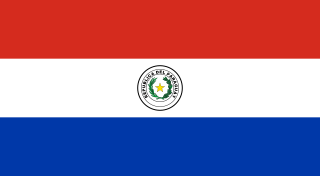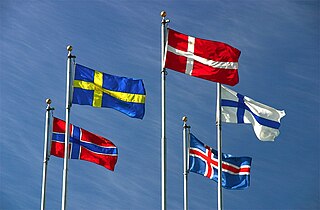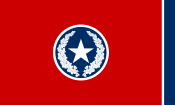
The flag of Missouri, often referred to as the Missouri flag, is the state flag of the U.S. state of Missouri. It consists of a triband of three equal horizontal stripes colored red, white, and blue, with the arms from the Great Seal of Missouri in the center. Designed by Mary Elizabeth Oliver, the red and white stripes represent valor and purity, respectively. The blue stripe represents the permanency, vigilance, and justice of the state. The three colors also highlight the French influence on the state in its early years. The Missouri flag was established on March 22, 1913, when governor Elliot Woolfolk Major signed the State flag act making it official.

The national flag of Lebanon is formed of two horizontal red stripes enveloping a horizontal white stripe. The white stripe is twice the height (width) of the red ones —a Spanish fess. The green cedar in the middle touches each of the red stripes and its width is one third of the width of the flag. The red stripes represent the blood shed by those who fought for Lebanon. The white stripe represents purity, peace and the snow-capped mountains of Lebanon. The cedar on the flag represents the citizens of Lebanon.

The flag of Paraguay was first adopted in 1842. Its design, a red–white–blue triband, was inspired by the colours of the French Tricolour, believed to signify independence and liberty. The flag is unusual because it differs on its obverse and reverse sides: the obverse of the flag shows the national coat of arms, and the reverse shows the seal of the treasury. It is the only national flag worldwide that has a unique design on each side. The flag consists of the same three horizontal colours as the flag of the Netherlands, which in turn was the inspiration for the French flag. It was revised in 2013 to bring the flag towards its original design. It has a ratio of 11:20.

The flag of Spain, as it is defined in the Constitution of 1978, consists of three horizontal stripes: red, yellow and red, the yellow stripe being twice the height of each red stripe. Traditionally, the middle stripe was defined by the more archaic term of gualda, and hence the popular name la Rojigualda (red-weld).

The flag of Sudan was adopted on 20 May 1970 and consists of a horizontal red-white-black tricolour with a green triangle at the hoist. The flag is based on the Arab Liberation Flag of the Egyptian Revolution of 1952, as are the flags of Egypt, Iraq, Syria, Yemen, and Palestine and formerly of the United Arab Republic, North Yemen, South Yemen, and the Libyan Arab Republic.

In vexillography, the canton is a rectangular emblem placed at the top left of a flag, usually occupying up to a quarter of a flag's area. The canton of a flag may be a flag in its own right. For instance, British ensigns have the Union Jack as their canton, as do their derivatives such as the national flags of Australia and New Zealand.

The coat of arms of Zimbabwe was adopted on 21 September 1981, one year and five months after the national flag was adopted. Previously the coat of arms of Zimbabwe was identical to the former coat of arms of Rhodesia.
A triband is a type of flag which consists of three stripes arranged to form a flag. These stripes may be two or three colours, and may have an emblem in the middle stripe. All tricolour flags are tribands, but not all tribands are tricolour flags, which requires three unique colours.

The flag of Indianapolis has a dark blue field with a white five-pointed star pointing upwards in the center. Around the star is a circular field in red. Surrounding the red field is a white ring, from which extend four white stripes from top to bottom and from hoist to fly, thus creating four equal quadrants in the field. The stripes are about one-seventh the width of the flag, with the white ring the same width as the stripes. The diameter of the red circle is about two-ninths the width of the flag.

The flags of New York City include the flag of New York City, the respective flags of the boroughs of The Bronx, Brooklyn, Manhattan, Queens, and Staten Island, and flags of certain city departments. The city flag is a vertical tricolor in blue, white, and orange and charged in the center bar with the seal of New York City in blue. The tricolor design is derived from the flag of the Dutch Monarchy—the Prince's Flag—as used in New Amsterdam in 1625, when that city became the capital of New Netherland.

The flag of Philadelphia is a blue and yellow triband featuring the Seal of Philadelphia.
The flag and coat of arms of Kedah are the state symbols of Kedah, Malaysia. Few distinctions are present between the flag and coat of arms of the state, as the flag consists of only a red field with the state arms on the upper hoist.

The flag of Cagayan is the provincial flag of Cagayan, Philippines. It is a horizontal triband of blue, gold and green, charged with the provincial coat-of-arms ringed by 29 white, five-pointed stars. It was adopted on March 11, 1970 by the virtue of Provincial Board Resolution No. 319.

The flag of Batangas is the provincial flag of Batangas, Philippines. It is a horizontal triband of blue, white, and red — the main colors of the Philippine flag — with the escutcheon taken from the provincial seal in the center.

The city flag of Knoxville, Tennessee was officially adopted by municipal ordinance on October 16, 1896. It is the third oldest official city flag in the United States and the oldest flag of any state or city governmental entity in Tennessee.

The current flag of San Jose, California features a triband of gold on top, white in the middle, and blue on the bottom with the city's official seal in the center. It has been the official flag since 1984.

The current city flag of Columbus, Ohio is a yellow-white-red vertical triband with the city seal on a blue field. Officially, the flag was adopted in 1929, although it is unknown if the flag was ever flown when it was first adopted.

The flag of Dayton, Ohio was adopted on December 15, 2021, and created by Dayton design and marketing firm Catapult Creative. The cost to the city for the design and an accompanying video was $4,300.

Flag families are sets of national flags with similarities in their design, often based on a shared history, culture, or influence. Families do not include flags with coincidental similarities. Flags may be in multiple flag families. Only twelve current national flags existed before the 19th century, when large-scale flag use began. Seven of these flags are the inspiration for more than 130 current national flags and ensigns.

The flag of Kansas City, simply known as the KC Flag, consists of two horizontal bars, red above blue, with a white stylized heart emblem. It is the seventh city flag for Kansas City.



















